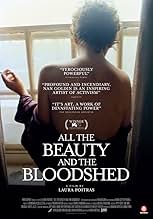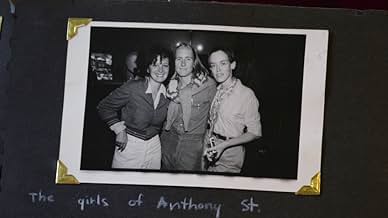La vida de la artista Nan Goldin y la caída de la familia Sackler, la dinastía farmacéutica responsable en gran medida del insondable número de víctimas mortales de la epidemia de opioides.La vida de la artista Nan Goldin y la caída de la familia Sackler, la dinastía farmacéutica responsable en gran medida del insondable número de víctimas mortales de la epidemia de opioides.La vida de la artista Nan Goldin y la caída de la familia Sackler, la dinastía farmacéutica responsable en gran medida del insondable número de víctimas mortales de la epidemia de opioides.
- Nominado a 1 premio Óscar
- 36 premios ganados y 57 nominaciones en total
- Self - Judge
- (as Judge Robert Drain)
- Self - Photographer and Friend of Nan
- (material de archivo)
- Self - Actor
- (material de archivo)
Opiniones destacadas
The choice to weave Nan's personal, artistic and activism journey all together is an interesting but risky one because it weakens the delivery on either one of them.
Personally, it feels like the film is putting Nan on a pedestal, instead of where she was most of her life, the dark, dirty and forgotten edges of the city. As a result, her on screen persona sometimes feels even more out of touch than a fictional character.
For what it's worth, the film comes back to the title in the end where it ties All The Beauty And The Bloodshed that Nan has seen throughout her whole life with who she is and what she is trying to achieve now. But it's just a little bit too late for my liking.
The amount of freedom you can experiment within a documentary has become more noticeable. In this one particularly, you see a bunch of different styles and even story branches.
There is a mix of themes such as topical activism, what can be classified as art, a determination for justice and accountability, a woman's struggling life and the power of family.
The central character I had no idea about and we certainly got a thorough look into her life both as an artist and as a daughter.
It felt very definitive as I felt it gave you the perfect portrait of this person's upbringing and how certain traumas lead to this groundbreaking change in the art world.
I also liked at how they told each aspect of her life in a parallel style. The timings of shift to a different part of her life felt well-timed and gave us a very satisfying conclusion.
This was pretty interesting and while I wasn't overwhelmed by it, I can see others feeling that way.
It's well made, the content and imagery is strong and the central character was not afraid to open herself up to her life story.
It's a powerful prologue, but, Poitras isn't simply interested in an advocacy documentary film here. It's a dense and intense exploration of Goldin, the person and the artist, and how her personal journey informed her activism.
Goldin is interviewed at length, and her personal writings and art are revealed in the most intimate manner. Goldin's photography evolved naturally. She was driven to document her own life and, from there, depicted an entire underground scene that had rarely been exposed to not only the art world - but, to the larger public. Goldin's fluid sexuality brought her to Provincetown and later the Burroughs of New York City, photographing everything and everyone she came in contact with. She never intentionally was putting together a portfolio - it just happened. The photographs are as private and personal as could be. Goldin never shied away from her innermost relationships, nor that of her circle of friends. That frankness is what eventually brought her to the recognition by the art world - even as it scandalized many of them. When AIDS hit her community, Goldin learned a lesson from the Act Up movement that carried on to her founding of P. A. I. N..
While all of that played out (eventually) in the public's eye, Poitras reveals Goldin's personal family life. Her strained relationship with her parents, and, most poignantly, of that with her sister who was institutionalized. Her sibling's story shows how a young woman's 'rebelliousness' can be struck down by the system and a forced dependency on drugs and a form of enslavement. It's something that Goldin carries with her to this day, including her own bout with opiods.
ALL THE BEAUTY AND THE BLOODSHED carries a lot on its plate. Poirtras' great achievement here is that no section of the movie feels out of place, nor does any part of it feel in any manner slighted. It's all of a piece melding Goldin's intensely personal quest, art and sense of social purpose.
Breathtaking.
A wonderful piece of factual storytelling focused around Nan Goldin's pursuit of justice and recompense for those helplessly hooked on Oxycontin, a drug that was peddled without remorse by people who thought they were above the law. The film also explores in some detail the life of Nan, her career as an artist, the wild and colourful characters she got to know in NYC, and the often crazy things she found herself doing, as well as her life as a child and the sister she lost.
There are vastly more powerful films about photographers, searing works about the opioid epidemic, beautiful films about artistic process. This film intersects with each of those genres, but in an insubstantial and unmemorable way.
The buzz around this work -- and there is a lot of buzz -- seems rooted in the celebrity of the filmmaker and its subject. That's ironic, for the film appears to seek its power from themes larger than any individual, yet winds up relevant only if underpinned by the fame surrounding its maker and central character. Like the reviewer here PedroPires90 wrote ("Unfocused," March 3, 2023), "honestly it was hard to find the strength to finish it."
¿Sabías que…?
- TriviaThe title of the film is a reference to Nan Goldin's older sister, Barbara Holly Goldin. It's a direct quote from a mental health evaluation of Barbara during her time at an institution. She died by suicide in 1965, at the age of 18. This film and Nan Goldin's 1986 "The Ballad of Sexual Dependency" are dedicated to her.
- Citas
Self - Nan's Mother: Droll thing life is -- that mysterious arrangement of merciless logic for a futile purpose. The most you can hope from it is some knowledge of yourself -- that comes too late -- a crop of inextinguishable regrets. Joseph Conrad, Heart of Darkness
- Bandas sonorasThe Cold Song
Performed by Klaus Nomi
Selecciones populares
- How long is All the Beauty and the Bloodshed?Con tecnología de Alexa
Detalles
- Fecha de lanzamiento
- País de origen
- Sitios oficiales
- Idioma
- También se conoce como
- All the Beauty and the Bloodshed
- Locaciones de filmación
- Nueva York, Nueva York, Estados Unidos(Metropolitan Art Museum protest)
- Productoras
- Ver más créditos de la compañía en IMDbPro
Taquilla
- Total en EE. UU. y Canadá
- USD 500,082
- Fin de semana de estreno en EE. UU. y Canadá
- USD 28,803
- 27 nov 2022
- Total a nivel mundial
- USD 1,483,975
- Tiempo de ejecución1 hora 53 minutos
- Color
- Mezcla de sonido
- Relación de aspecto
- 1.78 : 1









































